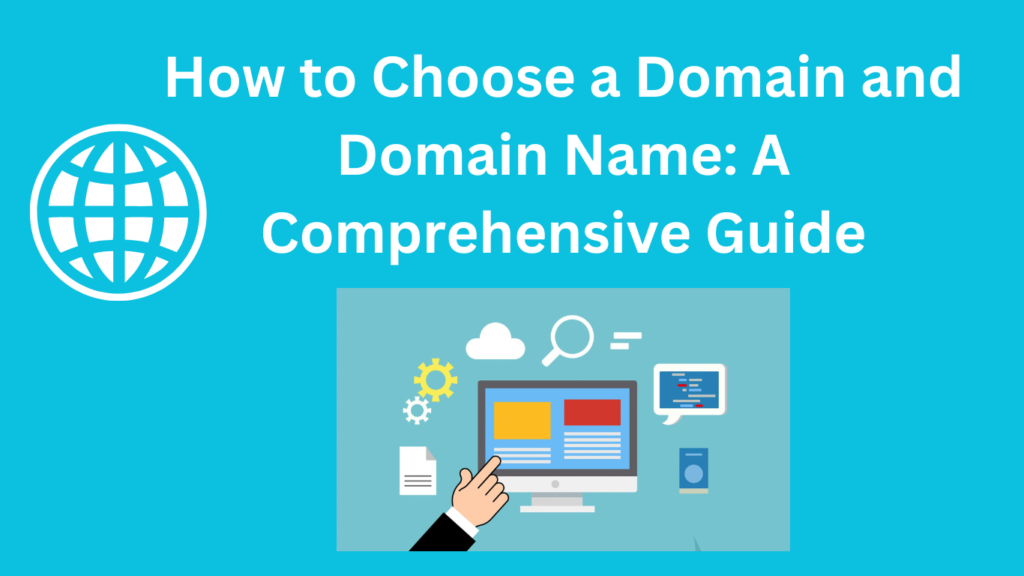How to Choose a Domain and Domain Name: A Comprehensive Guide
Your domain name is the foundation of your online presence. Think of it as your digital handshake—it’s how people first get to know your brand, how they’ll find you online, and what helps build trust right from the start. Choosing the right domain name and domain is like laying the cornerstone of your online presence—it sets the tone for your brand and builds the foundation for everything that follows. In this guide, we’ll explore the process of selecting a domain and domain name, with actionable tips to help you make the best choice for your brand or personal project.
Understanding Domains and Domain Names
A domain name is the address users type into their browsers to access your website, like www.example.com. It comprises two main parts:
- Second-Level Domain (SLD): This is the unique name of your website (e.g., “example” in
example.com). - Top-Level Domain (TLD): The suffix that follows the SLD, such as
.com,.org,.net, or newer options like.techor.online.
The domain itself is the entire address, while the domain name often refers specifically to the SLD.
Factors to Consider When Choosing a Domain Name
1. Relevance to Your Brand or Purpose
Your domain name should reflect your brand, business, or purpose. Whether you’re creating a personal blog, an e-commerce site, or a nonprofit organization, your domain name should:
1. Align with your business name or niche.
Example: A bakery named “Sweet Delights” might choose sweetdelights.com.
2. Communicate the core idea of your site.
Example: A tech blog could use techinsights.com.
2. Keep It Short and Memorable
Simplicity is key. A short and catchy domain name is easier for users to remember, type, and share. Avoid long, complex names that can confuse visitors or lead to typos.
Examples of short and memorable domains:
- Google.com
- Spotify.com
- Etsy.com
3. Easy to Spell and Pronounce
Your domain name should be intuitive. If people hear it, they should know how to spell it. Avoid using:
- Numbers (e.g., replacing “to” with “2”)
- Hyphens (e.g.,
best-site-ever.com) - Uncommon words or slang
4. Use Keywords Strategically
Incorporating keywords can improve SEO and make your site more discoverable. For instance, if you own a flower shop in New York, nyflowershop.com can help with search rankings and instantly tell users what your site offers.
Tip: Avoid keyword stuffing. A domain like bestcheapflowersinnewyork.com looks spammy and unprofessional.
5. Consider Your Target Audience
Understand your audience’s preferences and expectations. For instance:
- A tech-savvy audience might appreciate a modern TLD like
.tech. - A local audience may respond well to a domain with a geographic indicator, such as
bostonplumbing.com.
The TLD you choose can affect your branding, credibility, and SEO. Here are some common options:
1. Popular Generic TLDs
.com: The most widely recognized and trusted TLD. Ideal for businesses and general-purpose websites..org: Often used by nonprofits, open-source projects, and educational organizations..net: Commonly used for tech or internet-based companies.
2. New Generic TLDs
Modern TLDs like .tech, .shop, .blog, and .online allow for creative and industry-specific branding. For example:
- A startup in the tech industry might use
innovate.tech. - A blog about travel could opt for
wanderlust.blog.
3. Country-Code TLDs (ccTLDs)
If your website caters to a specific country, a ccTLD like .uk, .ca, or .in can enhance local appeal. For instance:
- A bakery in Canada might choose
maplebakery.ca. - A photographer in India could use
snapshots.in.
Note: Some ccTLDs, such as
.ioor.ai, have gained popularity outside their original geographic context, particularly in tech industries.
4. Specialty TLDs
Specialty TLDs are perfect for niche branding. Examples include:
.edufor educational institutions.govfor government websites.healthfor healthcare-related businesses
Tools to Help You Choose a Domain Name
1. Domain Name Generators
These tools can spark ideas and suggest available domains. Popular options include:
- Namecheap Domain Name Generator
- LeanDomainSearch
- DomainWheel
2. Check Availability
Ensure your desired domain name is available using tools like:
- GoDaddy
- Google Domains
- Bluehost
3. Trademark and Social Media Checks
Before committing, verify that your domain name isn’t trademarked and is available on social media platforms. Consistency across platforms enhances your brand identity.
Best Practices for Registering Your Domain
1. Choose a Reliable Domain Registrar
Register your domain through a reputable registrar like:
- GoDaddy
- Google Domains
- Namecheap
2. Register for Multiple Years
Most registrars allow you to register domains for one year at a time. However, registering for multiple years can:
- Save money
- Demonstrate commitment to your website (important for SEO)
3. Consider Domain Privacy Protection
Domain registrars often offer privacy protection services to hide your personal information from WHOIS databases, safeguarding you from spam and potential identity theft.
Common Mistakes to Avoid
1. Ignoring Future Scalability
Avoid limiting names like bestdogtoys2023.com if you plan to expand your offerings in the future.
2. Rushing the Decision
Take time to brainstorm, research, and gather feedback before finalizing your choice.
3. Focusing Only on Cost
Don’t compromise on quality or relevance to save a few dollars.
4. Neglecting Legal Aspects
Check for existing trademarks or copyrights to avoid legal complications.
Read More : How to Create Engaging Content with an AI YouTube Video Maker
Conclusion
Selecting the right domain and domain name is like choosing the perfect storefront for your business—it’s the first thing people see and can make or break their decision to engage with you. A thoughtful approach ensures your domain is memorable, relevant, and aligned with your brand’s goals. By considering factors like simplicity, SEO, and audience preferences, and using tools and best practices, you can secure a domain that sets you up for long-term success.
Take your time, research thoroughly, and don’t hesitate to seek professional advice if needed. A great domain name is not just an address; it’s a gateway to your digital success.
